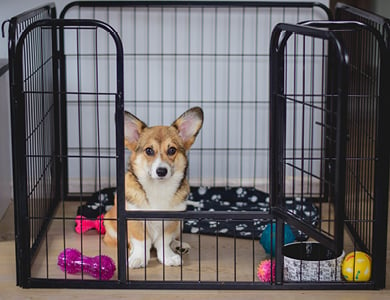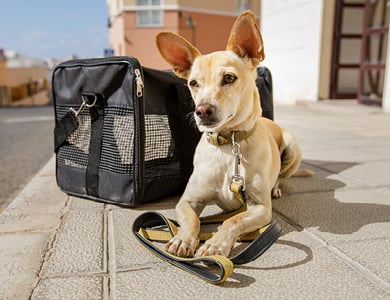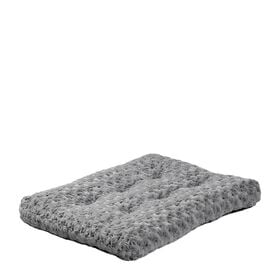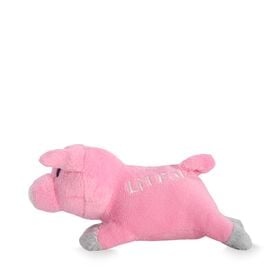The advantages of using a crate for your dog
- When used correctly, a crate becomes a reassuring space for dogs.
- A crate provides a safe space for dogs that might be prone to get into mischief or harm themselves by eating something hazardous, for example.
- A crate is a fantastic tool for a puppy. It provides an opportunity for a time out if your pet becomes too excited.
- If your pet tends to be very lively when guests arrive, a crate is a good way to prevent overexcitement.
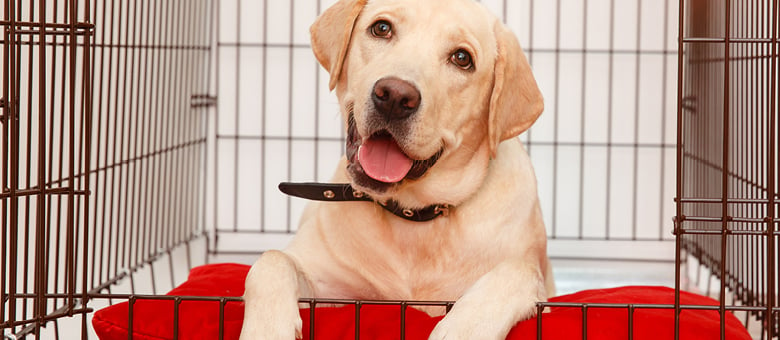
How to choose the right crate for your dog
Metal crates are definitely the most common choice. They are available in a range of sizes, and many cushions are even designed to fit inside them. A metal crate is also versatile: a divider can be placed inside the crate, allowing you to gradually adjust the available space for your puppy as it grows.
However, it’s important to choose a way of restraining your dog that you’re comfortable with. If you find that a metal crate is not suitable, create a safe space for your dog by choosing one of the following options:
- A plastic carrier (for puppies or small dogs)
- A soft crate (incredibly handy because you can easily fold it up and take it wherever you go)
- A pen (offers more space than a crate and is a good option if you have two small dogs that will be sharing the same space)
- A gate (an excellent choice if you just want to wall off an area in your home)
To ensure that your dog is comfortable in its space, keep the following three points in mind:
- Your dog must be able to comfortably lie down full outstretched.
- Your dog must be able to stand up without banging its head on the top of the crate.
- Your dog must be able to turn around inside the crate without any restriction.
Where should I put the crate?
It is recommended that you choose a spot that is often used by the family, such as the living room, and that you avoid isolated areas, such as the garage. However, if the spot you’ve chosen works, don’t change a thing.
If you have a puppy or a new dog, the crate should be in your room overnight to reassure your pet. You can also choose to keep your pet in your room overnight, without using a crate.
What should I put in the crate?
Ideally, you should put items in the crate that your dog won’t destroy, such as a cushion, a blanket or even your dog’s favourite toy. It’s strongly recommended that you use a kong (adapted to your pet’s age and size) filled with moist food (choose food that is most suitable for your dog and don’t hesitate to ask for advice). The purpose of the kong is to help your dog associate the time that it spends alone with something positive.
It’s important to always remove your dog’s collar when you leave it in its crate unsupervised to avoid possible injuries. It’s pointless to leave water in the crate because the dog is likely to spill it everywhere. Chewing bones should also be avoided in crates if you’re unable to supervise the activity.
How can I encourage my dog to happily go into its crate?
Here’s a really simple method that involves the use of a kong. The goal is to teach your dog that choosing to go into the crate comes with a treat. This is preferable to placing the kong directly in the crate in an effort to entice the dog because then you shut the door, leaving the dog feeling trapped. This type of experience isn’t nearly as positive. The following is the ideal way to attract your dog to its crate with a kong:
- Prepare a kong just before you’re ready to leave.
- Quietly move toward the crate and hold the kong above the door, being sure to keep the kong outside the crate.
- If your dog jumps for the kong, pull it back toward you and then hold it above the door again.
- As soon as your dog starts going into the crate, place the kong inside the crate.
- Shut the door, and repeat each time you have to leave your dog alone.
How long should I leave my dog in its crate?
Obviously, you have to proceed gradually with a puppy because it’s going through a stage of development that requires a great deal of your attention. There’s no right answer regarding the amount of time that a dog should be left in a crate. It all depends on the activities you do and the time you spend with the puppy when it’s not in its crate.
How do I know if my dog is comfortable in its crate?
It’s a good idea to take the time to film your dog for about an hour after you leave home, which will allow you to see if your dog is stressed and how long it takes the dog to get comfortable. If you suspect that your dog panics while you’re away, ask for help from a dog behaviour specialist.
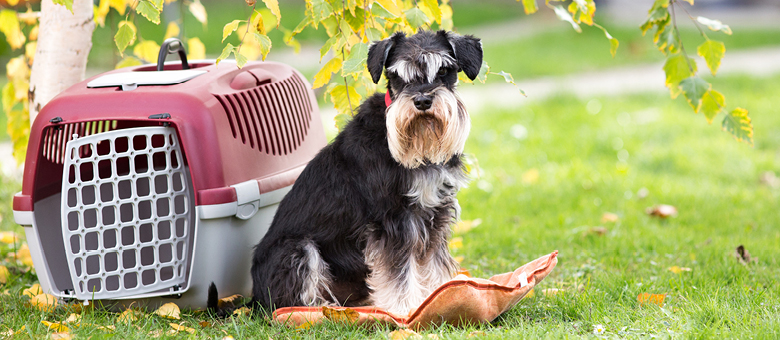
Until what age should my dog be put in a crate while I’m away?
It depends on your needs and your dog’s comfort level. You can decide to stop using the crate when you’re away from home, but to keep it around for other purposes or to give your dog the freedom to use it.
What should I do if my dog cries in its crate?
You might’ve heard that it’s a good idea to let a dog cry and bark in its crate, and that opening the crate door will only reinforce the behaviour. A dog should never learn to be alone while experiencing negative emotions. If you feel that your puppy or adult dog seems uncomfortable or panicked when it’s alone, you can intervene by either letting the dog out of the crate or simply reassuring it by staying close by.
Should I feed my dog while it’s in its crate?
You can feed your dog while it’s in its crate if you want to. This is a practical way of managing the meals of several dogs at once. Contrary to popular belief, this habit will not necessarily encourage your dog to like its crate.


